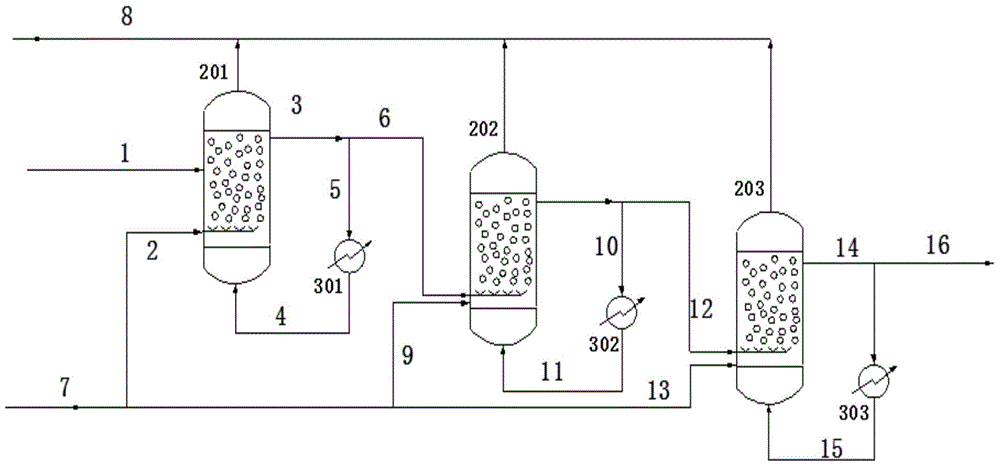Method for Reducing Energy Consumption of Oxidation Unit of Propylene Oxide Plant
A technology of propylene oxide and energy consumption, which is applied in the field of reducing the energy consumption of the oxidation unit of the propylene oxide device, can solve the problem of high energy consumption, achieve good technical effects, and reduce the power consumption of the device
- Summary
- Abstract
- Description
- Claims
- Application Information
AI Technical Summary
Problems solved by technology
Method used
Image
Examples
Embodiment 1
[0022] The production scale of propylene oxide is 100,000 tons / year, and two oxidation towers are installed. The operating temperature of the oxidation tower 201 is 110°C; the operating pressure is 0.30MPaG; the operating temperature of the cooler 301 is 110°C; the operating pressure is 0.30MPaG; the operating temperature of the oxidation tower 202 is 105°C; the operating pressure is 0.20MPaG; The operating pressure is 0.20MPaG; there is no circulating pump on the circulating liquid circulation pipeline, and the natural circulation is realized by relying on the density difference between the gas-liquid two-phase flow in the oxidation tower and the liquid phase flow in the circulation pipeline. The density difference between the gas-liquid two-phase flow in the oxidation tower and the liquid-phase flow in the circulation pipeline is 7.5. 70% of the liquid phase flow at the top of the oxidation tower is directly returned to the bottom of the oxidation tower through the circulati...
Embodiment 2
[0024] According to the conditions and steps described in Example 1, the production scale of propylene oxide becomes 150,000 tons / year, and three oxidation reactors are set. The operating temperature of the oxidation tower 201 is 110°C; the operating pressure is 0.30MPaG; the operating temperature of the cooler 301 is 110°C; the operating pressure is 0.30MPaG; the operating temperature of the oxidation tower 202 is 108°C; the operating pressure is 0.25MPaG; The operating pressure is 0.25MPaG; the operating temperature of the oxidation tower 203 is 105°C; the operating pressure is 0.20MPaG; the operating temperature of the cooler 303 is 105°C; the operating pressure is 0.20MPaG; The density difference of the stream is 7.5. 70% of the liquid phase flow at the top of the oxidation tower is directly returned to the bottom of the oxidation tower through the circulation line after passing through the cooler. Reduce electricity consumption by 1.0904 million kwh / year.
Embodiment 3
[0026] According to the conditions and steps described in Example 1, the production scale of propylene oxide is 100,000 tons / year, and two oxidation reactors are installed, but the operating conditions are changed. The operating temperature of the oxidation tower 201 is 120°C; the operating pressure is 0.35MPaG; the operating temperature of the cooler 301 is 120°C; the operating pressure is 0.35MPaG; the operating temperature of the oxidation tower 202 is 105°C; the operating pressure is 0.20MPaG; The operating pressure is 0.20 MPaG; the density difference between the gas-liquid two-phase flow in the oxidation tower and the liquid-phase flow in the circulation pipeline is 8.8. 64% of the liquid phase stream at the top of the oxidation tower is directly returned to the bottom of the oxidation tower through the circulation line after passing through the cooler. Reduce electricity consumption by 737,200 kWh / year.
PUM
 Login to View More
Login to View More Abstract
Description
Claims
Application Information
 Login to View More
Login to View More - R&D
- Intellectual Property
- Life Sciences
- Materials
- Tech Scout
- Unparalleled Data Quality
- Higher Quality Content
- 60% Fewer Hallucinations
Browse by: Latest US Patents, China's latest patents, Technical Efficacy Thesaurus, Application Domain, Technology Topic, Popular Technical Reports.
© 2025 PatSnap. All rights reserved.Legal|Privacy policy|Modern Slavery Act Transparency Statement|Sitemap|About US| Contact US: help@patsnap.com

